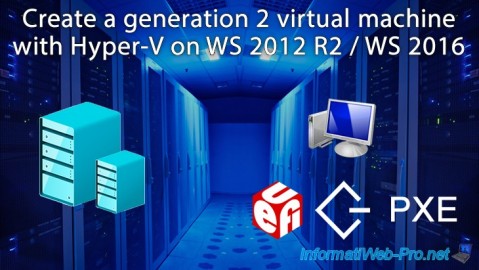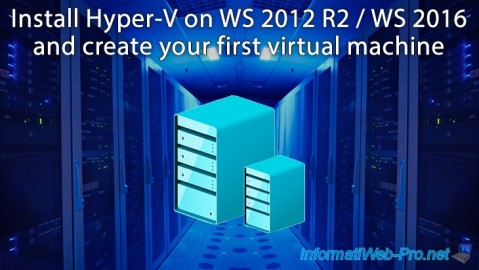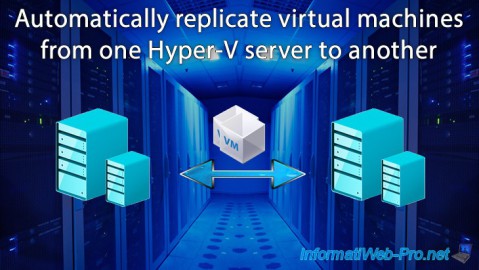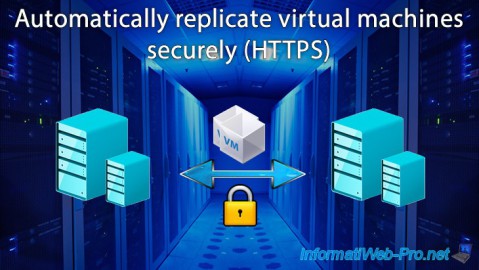Hyper-V server and generation 1 and 2 virtual machine settings on WS 2012 R2 or WS 2016
- Microsoft
- 20 December 2019 at 10:07 UTC
-

- 3/4
2.9. COM 1 and 2
In the "COM 1" and "COM 2" sections, you can connect a virtual COM port to a named pipe.
However, natively, it isn't possible to connect a virtual COM port to a physical COM port.

2.10. Diskette Drive
For Generation 1 virtual machines, you will be able to use a virtual floppy file in "vfd" format if you wish.

2.11. Name
In the "Name" section, you will be able to change the name of the virtual machine, as well as add notes about it.

2.12. Integration Services
In the "Integration Services" section, you will be able to configure the integration services that you have previously installed in the guest operating system.
The integration services available are :
- Operating system shutdown : allows the host to shut down a virtual machine
- Time synchronization : synchronizes the virtual machine time with the host server time
- Data Exchange : allows you to exchange metadata between the virtual machine and the host server
- Heartbeat : allows the virtual machine to report to the host server that it is still operating correctly
- Backup (volume checkpoint) : creates snapshots while maintaining data consistency during the backup process. This option corresponds to the VSS service.
- Guest services : enable file copying from the host server to the virtual machine and vice versa
For more information about Hyper-V integration services, refer to "Hyper-V Integration Services" page on Microsoft Docs.

2.13. Snapshot File Location (Checkpoint File Location)
With the "Snapshot File Location" (or Checkpoint File Location) option, you can choose where Hyper-V will store the snapshots (or checkpoints) of this virtual machine.

On Windows Server 2016, this section has been renamed "Checkpoints", because several options have been added there.
To start, you will have the possibility to enable or not the use of checkpoints (snapshots), but also to choose which type of checkpoints should be used :
- Production checkpoints : this new type of checkpoints allows you to create complete and consistent checkpoints for applications that are currently running in the guest operating system.
This is possible, because Hyper-V relies on the Volume Shadow Copy Service (VSS) present in the guest Windows operating system. This avoids the various problems that could have occurred with standard checkpoints.
If the guest operating system is Linux, then the file system buffers will be flushed so that the checkpoint created is consistent for applications running in it. - Standard checkpoints : old type of checkpoints used to quickly save and restore the state of a virtual machine.
However, these should only be used in test environments.
As you can see, by default your new virtual machines are configured to create production checkpoints (if possible) or standard checkpoints (if not).
This makes it possible to favor the use of new production checkpoints to maintain data consistency as much as possible for the applications that run in the virtual machine concerned.
Source : Production checkpoints - Microsoft Docs.

2.14. Smart Paging File Location
Here, you will be able to choose where to store the smart paging file for this virtual machine.
The smart paging file corresponds to a virtual memory file that will be used temporarily as random access memory by the virtual machine.
This file is temporarily created on the server's hard disk and is usually used when the virtual machine is restarted and when the Hyper-V server cann't allocate the amount of RAM that it needs to restart.

2.15. Automatic Start Action
The "Automatic Start Action" option allows you to choose whether Hyper-V should automatically start this virtual machine when the server finishes booting.
The available values are :
- Nothing : the virtual machine will not start automatically when the server starts
- Automatically start if it was running when the service stopped : if the virtual machine was started when the server shutdown was started, then it will be restarted automatically after the server restarts
- Always start this virtual machine automatically : the virtual machine will always start automatically when the Hyper-V server starts
You will also be able to choose the boot time for this virtual machine. Which is useful when one virtual machine depends on another. For example, if you have a virtualized DNS or Active Directory server that is required for the other virtual machines to function properly.

2.16. Automatic Stop Action
This option is similar to the previous one, except that it concerns the shutdown of the server.
You will have the possibility :
- to save the state of the virtual machine when the Hyper-V server is shut down : so, the Hyper-V server will suspend the virtual machine before its shutdown.
- to shut down the virtual machine when the Hyper-V server is shut down : shut down the virtual machine before shutting down the Hyper-V server. This is not recommended, because it can crash the guest operating system.
- to shut down the guest operating system : to properly shut down the virtual machine by shutting down the guest operating system as if you had shut down the virtual machine from the guest operating system.
Warning : this feature requires that the Integration Services be installed in the guest operating system and that the "Operating system shutdown" box be checked in the "Integration Services" section of this virtual machine's settings.

Share this tutorial
To see also
-

Microsoft 9/6/2019
Hyper-V (WS 2012 R2 / 2016) - Create a generation 2 VM
-

Microsoft 8/10/2019
Hyper-V (WS 2012 R2 / 2016) - Install Hyper-V and create your first VM
-

Microsoft 11/8/2019
Hyper-V (WS 2012 R2 / WS 2016) - Automatically replicate virtual machines
-

Microsoft 11/15/2019
Hyper-V (WS 2012 R2 / WS 2016) - Automatically replicate virtual machines (securely)

No comment